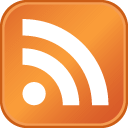Getting Started with Web Feeds
What's a web feed?

You can also get updates via e-mail. Just sign up for our mailing list.
A web feed is a special kind of webpage that contains information in a structured format called XML. This computer-readable
format enables software, called a feed reader, to help you keep track of which of your favorite websites has been
recently updated, and which you've already read.
How can web feeds benefit me?
Web feeds can easily save you hundreds of hours if you spend a lot of time reading news or blogs on the web.
What websites have web feeds?
Essentially every weblog and every major news site and magazine offers web feeds. Corporate press sites now offer
web feeds, as well as other sites that offer regularly updated content. You can even get search results in web
feed format.
How can I tell if a webpage has a web feed?
Web feeds used to be indicated by an orange icon that said XML, RSS, or ATOM. Today, no matter what format it's
in, a web feed is usually indicated by the icon above, usually small and orange. Seeing that icon should tip you
off to the presence of a webfeed on that page.
In Firefox and Internet Explorer 7, the feed toolbar button (which looks the same as that icon) will light up
orange when you visit a page that has a web feed. Clicking that toolbar button will add the feed to the browser's
built-in feed reader.
How do I get started reading feeds?
First, you need a feed reader. You can get feed readers as software that you install on your computer, or you
can set up an account at a feed reading website to read feeds. Here's a list of readers you can try.
- NewsGator/FeedDemon
NewsGator Inbox is a plug-in for Microsoft Outlook to allow you to read web feeds inside the popular email client.
Note that Outlook 2007 will have this capability built-in. But NewsGator also provides you the option to sync
your feeds to the NewsGatorOnline website that, like Bloglines, lets you read your feeds anywhere. You can also
view your feeds on your TV screen if you're running Windows Media Center Edition. And the same company also provides
an advanced stand-alone client for Windows called FeedDemon and for Mac called NetNewsWire. Each component of
this suite costs money. But you can use NewsGator Online by itself for free, and it has a prettier interface than
the more popular Bloglines.
- SharpReader
A simple, lightweight, easy-to-use reader for Windows. Free.
- Onfolio for Windows Live Toolbar
Install Microsoft's Windows Live Toolbar in your browser and add the Onfolio plug-in. Onfolio allows you to read
feeds in an innovative 'newspaper' view and capture feed items and websites to a local store. Free.
- Bloglines.com
Perhaps the easiest way to get started reading feeds. Set up an account at Bloglines and you can read your feeds
anywhere you have access to the web. Free.
- Google Reader, Live.com,
NetVibes, etc.
Any of these portal-style sites allow you to add web feeds to show on your customized page. If you already use
the customization features of these sites, you may want to use the site as your feed reader as well. If not, you should
probably pick a dedicated reader for more functionality. Free.
No matter what reader you choose, you can export a list of feeds from any of them in a format called OPML. You
can then import the OPML file into the reader you want to switch to, making switching almost painless.
Once you've got your feed reader picked out and installed or your account set up, start hunting for feeds. Look
for the feed icon on your favorite news sites or blogs. (Ours is at the bottom of this page.) Click it. Some feeds,
like ours, will provide a variety of buttons that allow you to add your feed to your feed reader automatically.
If the feed doesn't have such a button, you can just copy the address, starting with http:// from the address
bar and paste it into your feed reader.
Once you've got your feed list set up, read your feeds! Mark each feed item as read as you read it. Then, when
the feed is updated, your feed reader software will show you at a glance that there are new items.